EduTrack Developer Guide
Acknowledgements
- JavaFX
- Jackson
- JUnit5
- This project is adapted from AddressBook Level 3 (AB3) by SE-EDU.
Setting up, getting started
Refer to the guide Setting up and getting started.
Design
Tip: The .puml files used to create diagrams used in this document can be found in the diagrams. Refer to the PlantUML Tutorial at se-edu/guides to learn how to create and edit diagrams.
Architecture
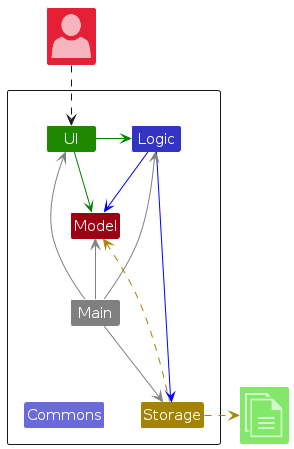
The Architecture Diagram given above explains the high-level design of the App.
Below is a quick overview of the main components and how they interact with each other.
Main components of the architecture
Main (consisting of classes Main and MainApp) is in charge of the app launch and shutdown.
- At app launch, it initializes the other components in the correct sequence and connects them up with each other.
- At shutdown, it shuts down the other components and invokes cleanup methods where necessary.
The bulk of the app's work is done by the following four components:
UI: The UI of the App.Logic: The command executor.Model: Holds the data of the App in memory.Storage: Reads data from, and writes data to, the hard disk.
Commons represents a collection of classes used by multiple other components.
How the architecture components interact with each other
The Sequence Diagram below shows how the components interact with each other for the scenario where the user issues the command delete 1.
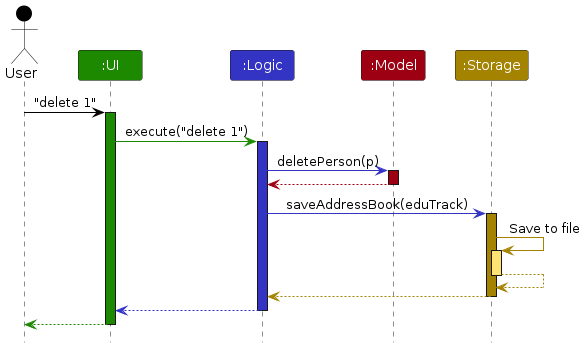
Each of the four main components (also shown in the diagram above),
- defines its API in an
interfacewith the same name as the Component. - implements its functionality using a concrete
{Component Name}Managerclass (which follows the corresponding APIinterfacementioned in the previous point.
For example, the Logic component defines its API in the Logic.java interface and implements its functionality using the LogicManager.java class which follows the Logic interface. Other components interact with a given component through its interface rather than the concrete class (reason: to prevent outside component's being coupled to the implementation of a component), as illustrated in the (partial) class diagram below.
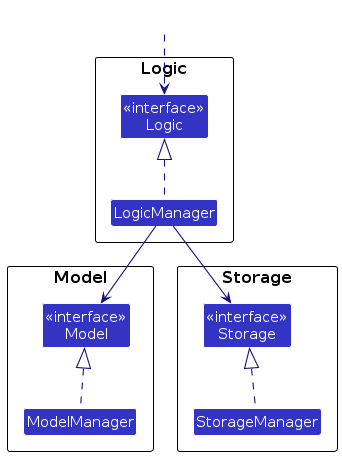
The sections below give more details of each component.
UI component
The API of this component is specified in Ui.java
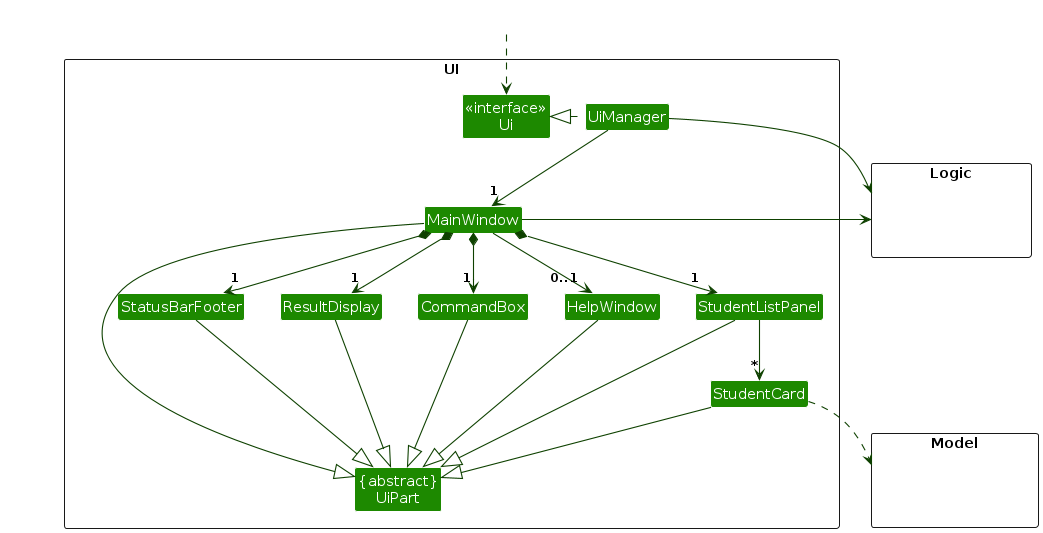
The UI consists of a MainWindow that is made up of parts e.g.CommandBox, ResultDisplay, ClassListPanel, StudentListPanel , StatusBarFooter etc. All these, including the MainWindow, inherit from the abstract UiPart class which captures the commonalities between classes that represent parts of the visible GUI.
The UI component uses the JavaFx UI framework. The layout of these UI parts is defined in matching .fxml files that are in the src/main/resources/view folder. For example, the layout of the MainWindow is specified in MainWindow.fxml
The UI component,
- executes user commands using the
Logiccomponent. - listens for changes to
Modeldata so that the UI can be updated with the modified data. - keeps a reference to the
Logiccomponent, because theUIrelies on theLogicto execute commands. - has specific updates based on certain commands e.g.
ListCommandwill update thelistPanelPlaceholderto replace theStudentListPanelwith theClassListPaneland vice versa. - depends on some classes in the
Modelcomponent, as it displaysStudentandClassobjects residing in theModel.
Logic component
API : Logic.java
Here's a (partial) class diagram of the Logic component:
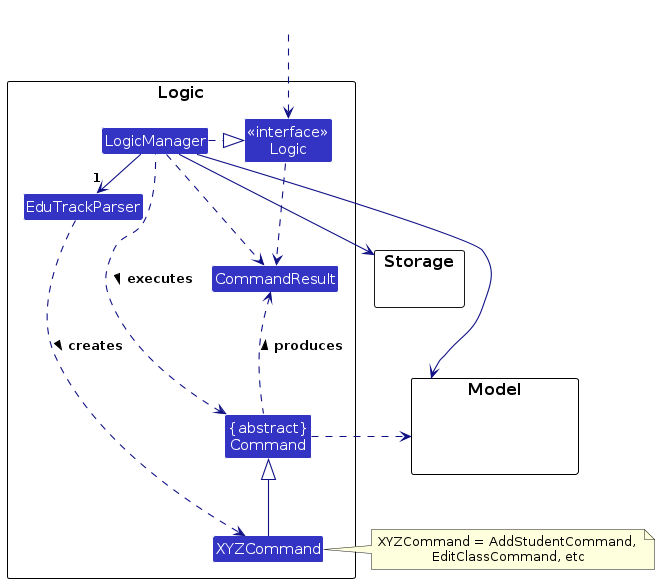
The sequence diagram below illustrates the interactions within the Logic component, taking execute("delete 1") API call as an example.
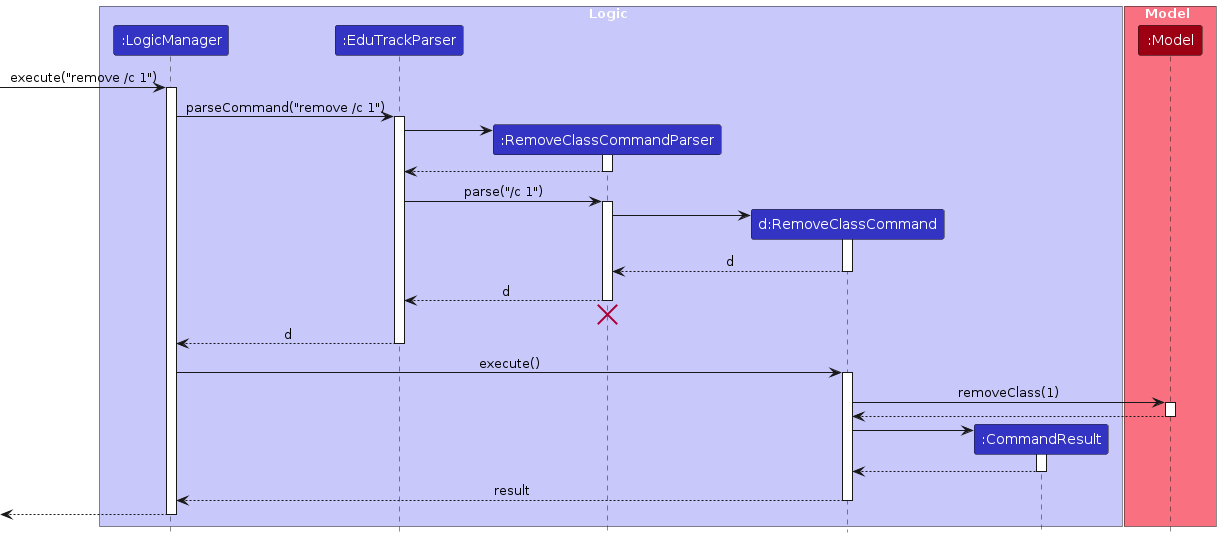
Note: The lifeline for RemoveClassCommandParser should end at the destroy marker (X) but due to a limitation of PlantUML, the lifeline reaches the end of diagram.
How the Logic component works:
- When
Logicis called upon to execute a command, it is passed to anEduTrackParserobject which in turn creates a parser that matches the command (e.g.,DeleteCommandParser) and uses it to parse the command. - This results in a
Commandobject (more precisely, an object of one of its subclasses e.g.,RemoveClassCommand) which is executed by theLogicManager. - The command can communicate with the
Modelwhen it is executed (e.g. to remove a class). - The result of the command execution is encapsulated as a
CommandResultobject which is returned back fromLogic.
Here are the other classes in Logic (omitted from the class diagram above) that are used for parsing a user command:
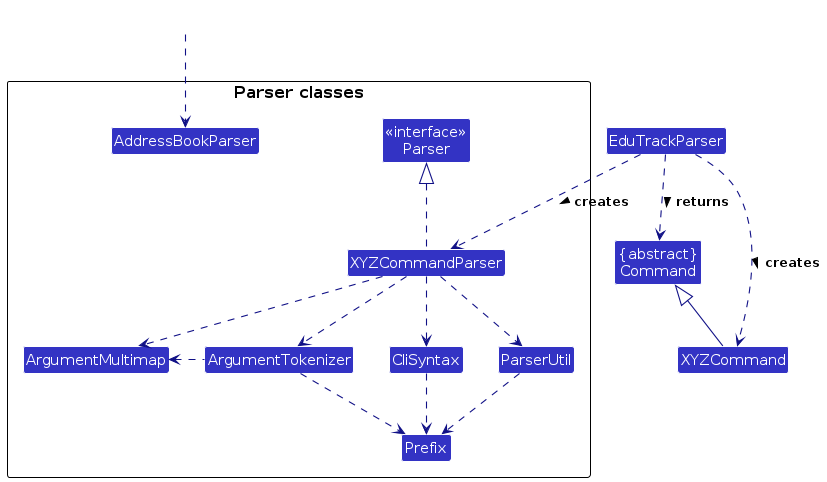
How the parsing works:
- When called upon to parse a user command, the
EduTrackParserclass creates anXYZCommandParser(XYZis a placeholder for the specific command name e.g.,AddStudentCommandParser) which uses the other classes shown above to parse the user command and create aXYZCommandobject (e.g.,AddStudentCommand) which theEduTrackParserreturns back as aCommandobject. - All
XYZCommandParserclasses (e.g.,AddStudentCommandParser,RemoveClassCommandParser, ...) inherit from theParserinterface so that they can be treated similarly where possible e.g, during testing.
Model component
API : Model.java
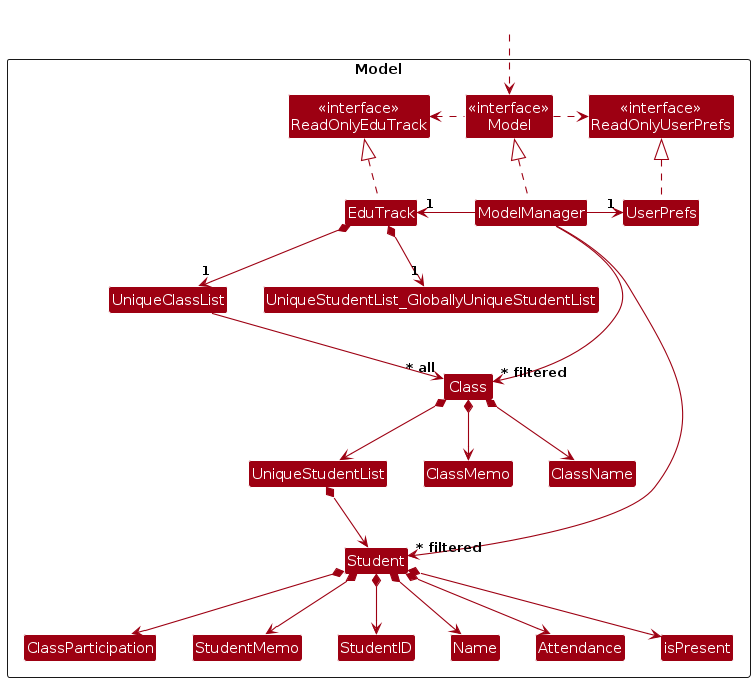
The Model component,
- stores the class administrative data i.e., all
Classobjects (which are contained in aUniqueClassListobject) andStudentobjects (which are contained in aUniqueStudentList). - stores the currently 'selected'
Classobjects (e.g., results of a search query) as a separate filtered list which is exposed to outsiders as an unmodifiableObservableList<Class>that can be 'observed' e.g. the UI can be bound to this list so that the UI automatically updates when the data in the list change. - stores a
UserPrefobject that represents the user’s preferences. This is exposed to the outside as aReadOnlyUserPrefobjects. - does not depend on any of the other three components (as the
Modelrepresents data entities of the domain, they should make sense on their own without depending on other components)
Storage component
API : Storage.java
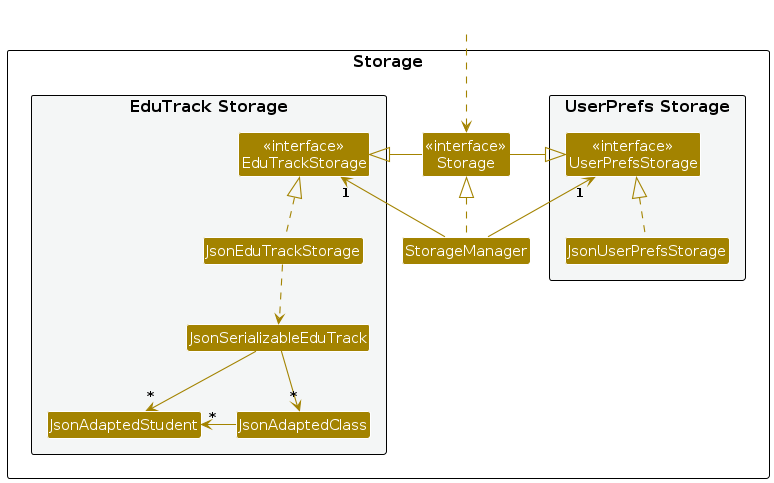
The Storage component,
- can save both EduTrack data and user preference data in JSON format, and read them back into corresponding objects.
- inherits from both
EduTrackStorageandUserPrefStorage, which means it can be treated as either one (if only the functionality of only one is needed). - depends on some classes in the
Modelcomponent (because theStoragecomponent's job is to save/retrieve objects that belong to theModel)
Common classes
Classes used by multiple components are in the seedu.edutrack.commons package.
Implementation
This section describes some noteworthy details on how certain features are implemented.
Mark student's attendance as present
Implementation
The following object diagram shows how different instances interact with each other.

Walkthrough:
Do use the sequence diagram
Step 1. The user executes mark /s 1 /c CS2103T to mark the 1st student in the class CS2103T.
Step 2. MarkStudentPresentCommandParser creates a new MarkStudentPresentCommand with the required fields.
Step 3. LogicManager calls MarkStudentPresentCommand#excecute().
Step 4. MarkStudentPresentCommand calls Model#getClass to obtain the Class instance, sClass
Step 5. MarkStudentPresentCommand calls Model#getStudentInClass to obtain the Student instance s
Step 6. MarkStudentPresentCommand calls Student#duplicateStudent to create a duplicate Student, duplicateS.
Step 7. MarkStudentPresentCommand calls Model#markStudentPresent.
Step 8. Model#markStudentPresent calls Student#markStudentPresent to mark the duplicateS as present, this updates both sLessonsAttended and sCurrentLessonAttendance.
Step 9. Model#markStudentPresent calls EduTrack#setStudent and Model#setStudentInClass to replace s as with duplicateS in EduTrack's globalStudentList and the sClass.
Step 10. Model#markStudentPresent calls the Model#updateFIlteredStudentList to update the GUI of Students shown to user.
Step 11. CommandResult is returned.
Note: If the command fails its execution, both the StudentList in EduTrack and StudentList in the class remain unchanged. An error message will be printed to notify the user.
Execution flow of Mark student as present:
The following sequence diagram shows how the MarkStudentPresent operation works:
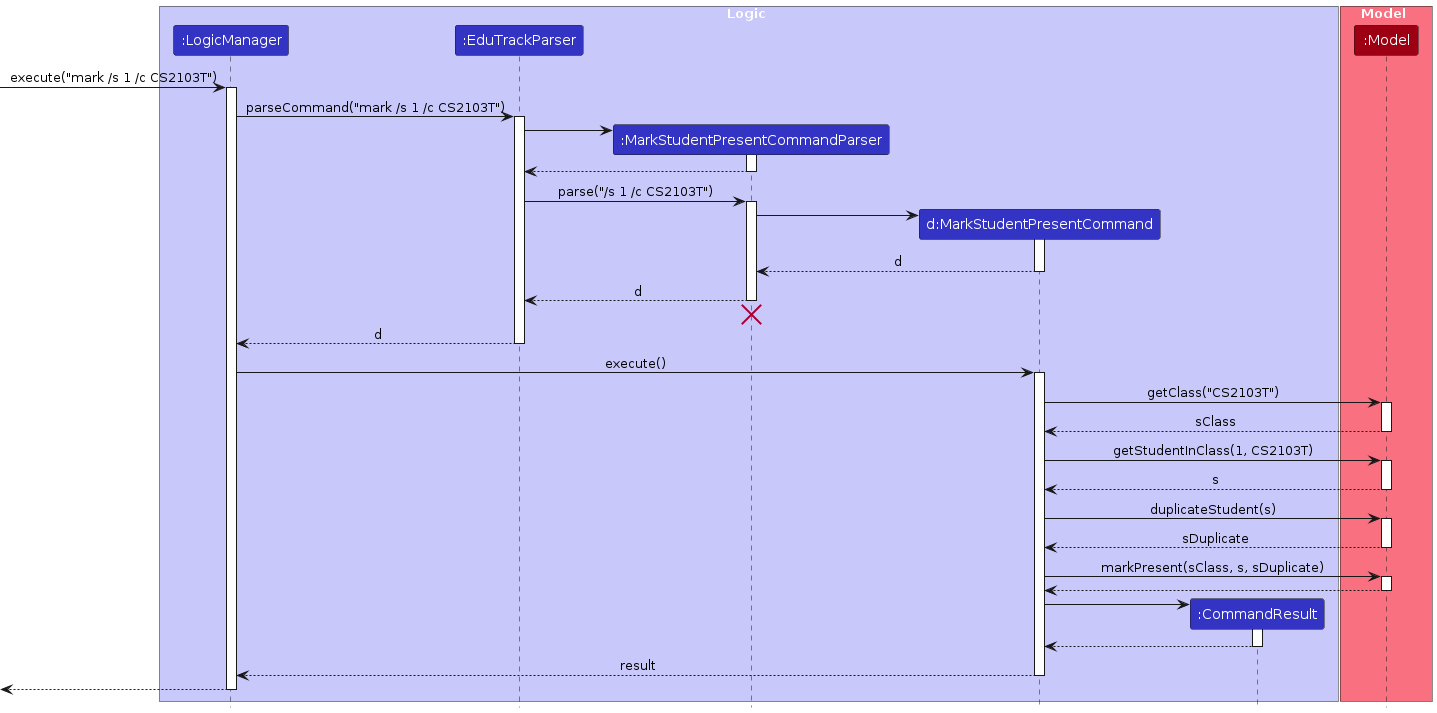
User-EduTrack interaction diagram:
The following activity diagram shows what happens when a use executes the MarkStudentPresentCommand:
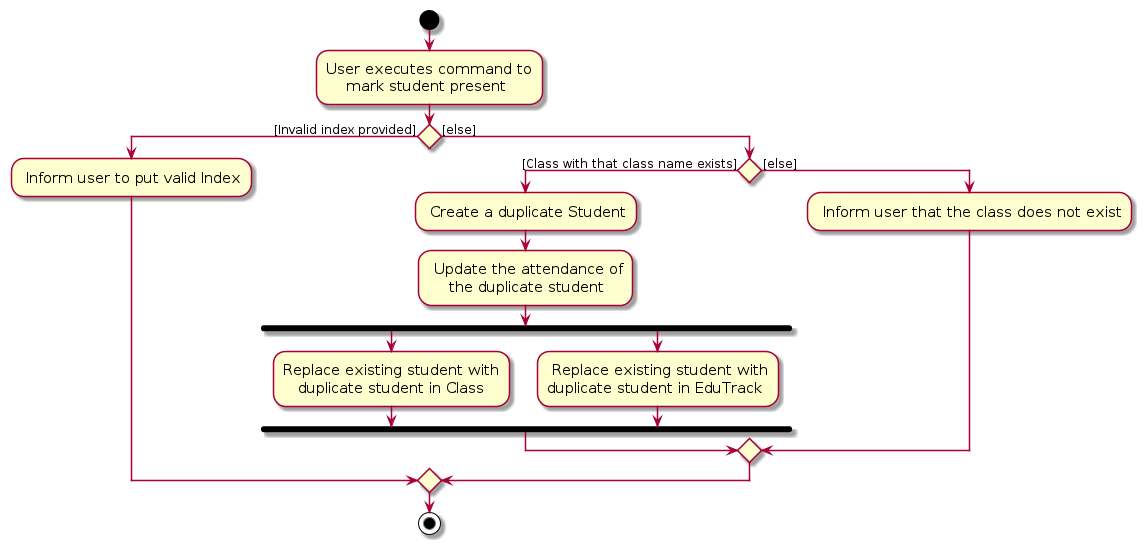
Design considerations:
Aspect: Method of calculating the number of lessons attended
- Alternative 1 (current choice): Maintain an overall counter for the number of lessons the student attended.
- Pros: Easy to implement.
- Cons: Unable to store the individual state of each lesson. Determining which lesson user attended is not possible.
- Alternative 2: Maintain the state of each lesson with an array.
- Pros: Enable users to view or modify the state of each lesson. This may lead to more consistency in data, since the number of lessons and length of the array are related.
- Cons: Difficult to implement. More memory usage, and predefined maximum lessons are required for array creation, although using ArrayList would be possible as well.
Edit Student feature
Implementation
The edit /s command is facilitated by creating an EditStudentCommand depending on the given input.
This command will update the student's details and update the model accordingly.
The edit student command accepts:
- Compulsory parameters
- Student's index in the class
- Class name of the student's class
- At least one of these parameters
- Name
- Id
- Memo
- Class Participation
The following activity diagram summarizes what happens when a user executes an edit /s command.
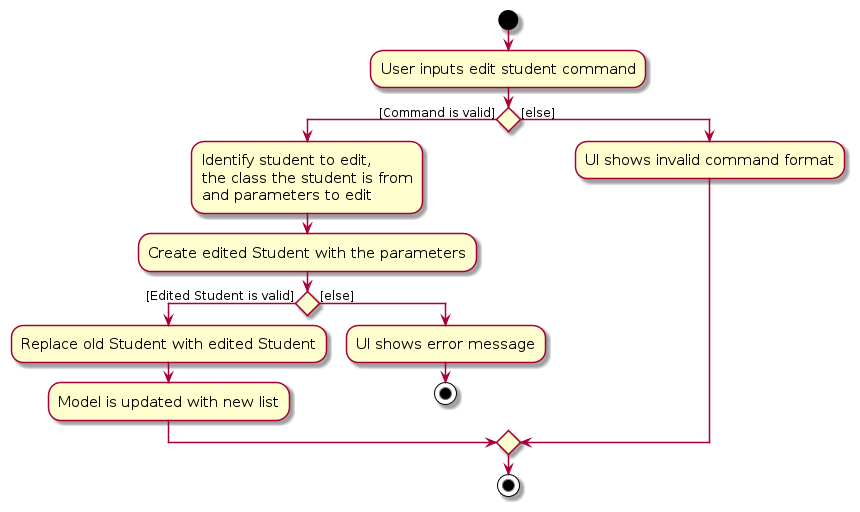
Given below is an example usage scenario and how the edit student operation behaves at each step.
Step 1. A valid command edit /s 1 /c CS2103T /n John is given as a user input. This invokes LogicManager#execute(), which calls EduTrackParser#parseCommand() to parse the above command into command word edit /s and command argument /s 1 /c CS2103T /n John.
Step 2. EditStudentCommandParser is initialized based on the parse results and EditStudentCommandParser#parse() is called. EditStudentCommandParser#parse() will call ArgumentTokenizer#tokenize() to identify all the prefixes such as Index of the Student being edited as well as the ClassName the student is supposed to be in. (ie. 1 and CS2103T respectively). It will also obtain an ArgumentMultimap of prefixes to their respective arguments (ie. /n is mapped to John).
Step 3. EditStudentCommandParser#parse() then initializes and EditStudentDescriptor that stores the details to edit the student with. Thus, EditStudentDescriptor#setName() will be called to store John as the Name to be edited.
Step 4. EditStudentCommandParser#parse() then initializes an EditStudentCommand with the Index, ClassName, and EditStudentDescriptor as an argument. EditStudentCommand#execute() is then called, which creates a new Student and copies over the details to be edited from the EditStudentDescriptor into both the UniqueStudentList of the Class and EduTrack.
Step 5. After checking that the new Student is not a duplicate using Class#hasStudentInClass() and Student#isSameStudent(), Model#setStudent and Model#setStudentInClass will be called to replace the specified Student. Finally, Model#updateFilteredStudentList() is called to reflect the changes made to the Student.
Step 6. CommandResult is then initialized with the String containing MESSAGE_EDIT_PERSON_SUCCESS and Student which will then be returned.
The following sequence diagram shows how the edit student operation works:
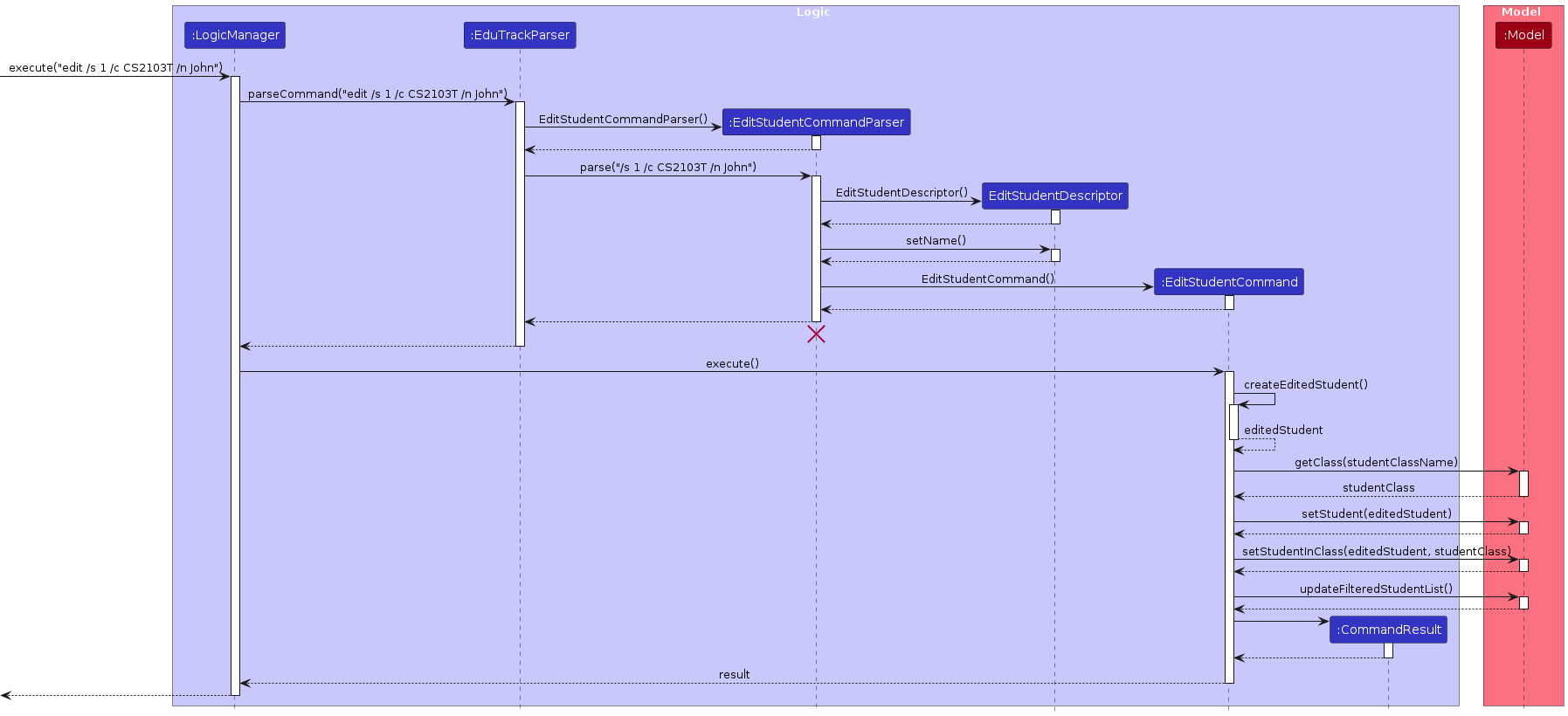
Note: The lifeline for EditStudentCommandParser should end at the destroy marker (X) but due to a limitation of PlantUML, the lifeline reaches the end of diagram.
Remove Student feature
Implementation
The removal of Student implements the following operation:
EduTrack#removeStudent(Student s)— Removessfrom the list of students inEduTrackthat tracks all students.Class#removeStudent(Student s)— Removessfrom the list of students inClassthat tracks all students inClass.
These operations are exposed in the Model interface as Model#deleteStudent(Student s) and Model#deleteStudent(Student s, Class sClass).
Given below is an example usage scenario of the remove student mechanism at a high level:
Step 1. The user inputs remove /s 1 /c CS2103T command to remove the first Student in the class named "CS2103T".
Step 2. Logicis called upon to execute the above command, it is passed to an EduTrackParser object which in turn
create a RemoveStudentCommandParser and uses it to parse the command.
Step 3. This results in RemoveStudentCommand, referred to as cmd in this scenario, which is executed by the LogicManager.
Step 4. cmd communicates with the Model when executed to remove the first Student in Class CS2103T.
Step 5. The result of the command execution is encapsulated as a CommandResult object which is returned back to Logic.
The scenario is depicted by this sequence diagram. For execution of cmd, refer to this sequence diagram.
Remove Student Mechanism
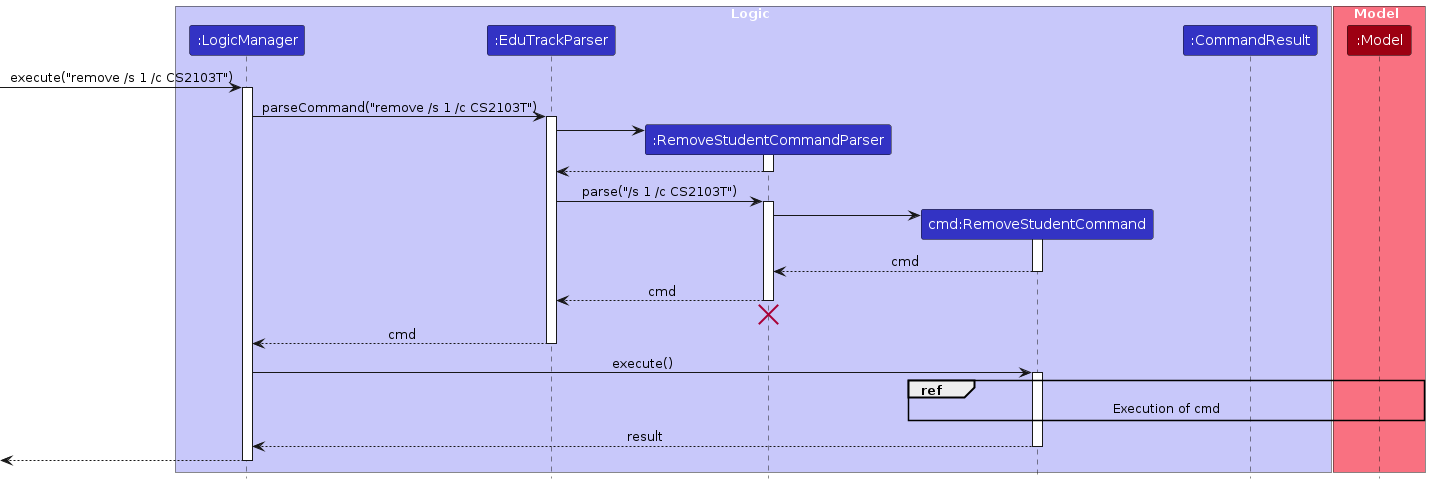
Note: The lifeline for RemoveStudentCommandParser should end at the destroy marker (X) but due to a limitation of PlantUML, the lifeline reaches the end of diagram.
The mechanism to execute a RemoveStudentCommand is elaborated in the below walkthrough.
This is a list of variables used in the walkthrough for clarity.
Variables used:
cmd - RemoveStudentCommand communicates with Model to remove a Student
s - Student to be removed.
sName - Name representing s.
sClass - Class of s.
studentClassName - ClassName representing sClass.
sClassStudentList - UniqueStudentList in sClass containing all its Student
globalStudentList - UniqueStudentList in EduTrack containing all Student across all Class.
The relationship between variables can be summarised by this object diagram.
Relationship between key variables
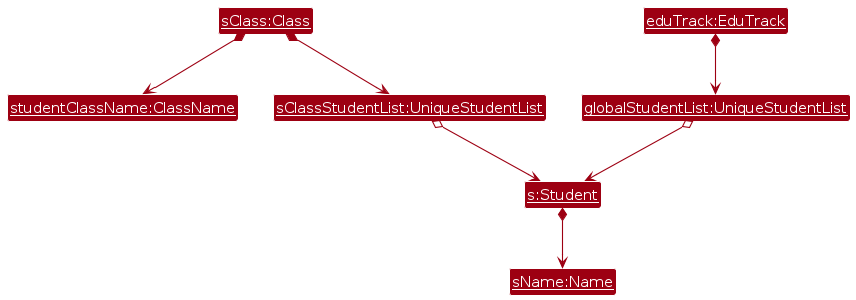
Walkthrough
Step 1. LogicManager calls RemoveStudentCommand#execute().
Step 2. cmd calls Model#getClass(studentClassName) to get sClass.
Step 3. cmd calls Model#getStudentList(sClass) to get the sClassStudentList from sClass.
Step 4. cmd calls Model#getStudent(sClassStudentList, 1) to get s, the first student in the sClassStudentList.
Step 5. cmd calls Model#getStudentName(s) to get sName.
Step 6. cmd calls Model#deleteStudent(s, sClass) to remove s from sClassStudentList.
Step 7. cmd calls Model#deleteStudent(s) to remove s from globalStudentList.
Step 8. The result of the cmd's execution is encapsulated as a CommandResult object.
Step 9. cmd returns CommandResult to LogicManager.
The walkthrough can be summarised by this sequence diagram. (Some details are omitted in the diagram)
Execution of a RemoveStudentCommand
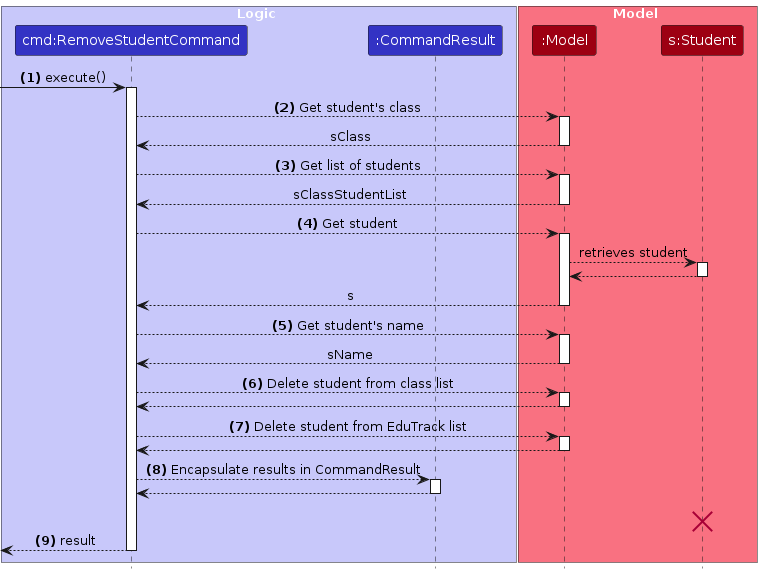
Note: The lifeline for Student should end at the destroy marker (X) but due to a limitation of PlantUML, the lifeline reaches the end of diagram.
The following activity diagram summarises what happens when a user removes a Student:
Remove Student Workflow
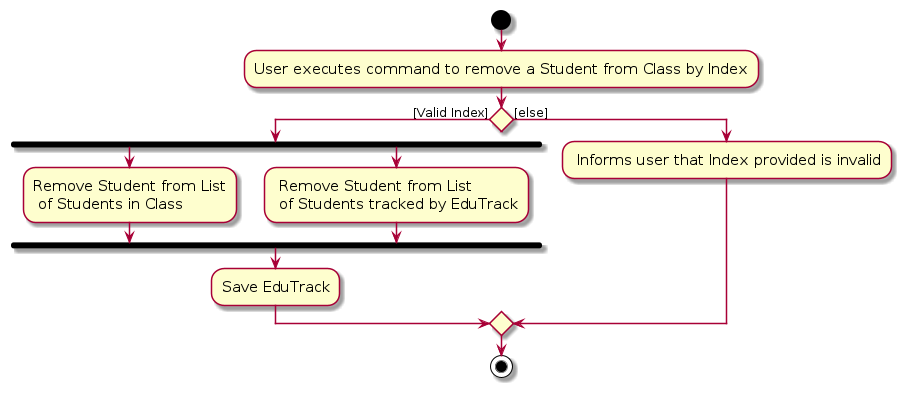
Implementation reasoning:
RemoveStudentCommandleverages multiple methods from other classes to enhance abstraction, ultimately promoting higher cohesion within the system.RemoveStudentCommandis responsible for deletion ofsfromglobalStudentListunderEduTrackto enable the creation ofStudentwith sameNamein the future. This is necessary becauseEduTrackenforces the uniqueness of student names in theglobalStudentList.
View Class feature
Implementation
The View Command feature allows users to list all students in a specified class. It is implemented as follows:
Model#updateFilteredClassList(Predicate<Class> predicate)— Updates the filtered class list based on a given predicate. This is used to display the specified class along with its students.Model#updateFilteredStudentList(Predicate<Student> predicate)— Updates the filtered student list based on a given predicate. In this case, it filters students belonging to the specified class.Model#getClassByIndex(Index classIndex)— Retrieves the class object based on the provided index.Class#getStudentList()— Gets the list of students associated with a specific class.Class#getClassName()— Gets the name of the class for display purposes.CommandResult— Returns a command result with a success message indicating the class name.
The workflow of the View Command feature is outlined below:
The user invokes the View Command with a specified class index.
The command is executed, calling the appropriate methods in the
Model.The
Modelupdates the filtered class list to be reset to all classes.The specified class is retrieved using the class index.
The
Modelupdates the filtered class list again, this time with a predicate that filters for the specified class.The filtered student list is updated to show only students belonging to the specified class.
The command returns a success message with the name of the class.
Variables used:
classIndex- The index of the class specified by the user.classToView- The class object corresponding to the specified index.classToTest- A class used in the filtering predicate.student- A student object used in the filtering predicate.
The interaction between these variables is illustrated in the following object diagram:

Walkthrough
LogicManager calls
ViewCommand#execute().ViewCommandcallsModel#getClassByIndex(classIndex)to retrieve the class object corresponding to the specified index.ViewCommandcallsModel#updateFilteredClassList(Predicate<Class> predicate)to update the filtered class list.ViewCommandcallsModel#updateFilteredStudentList(Predicate<Student> predicate)to update the filtered student list which is displayed on the UI.ViewCommandreturns aCommandResultwith a success message.
The interaction between these variables is illustrated in the following sequence diagram:
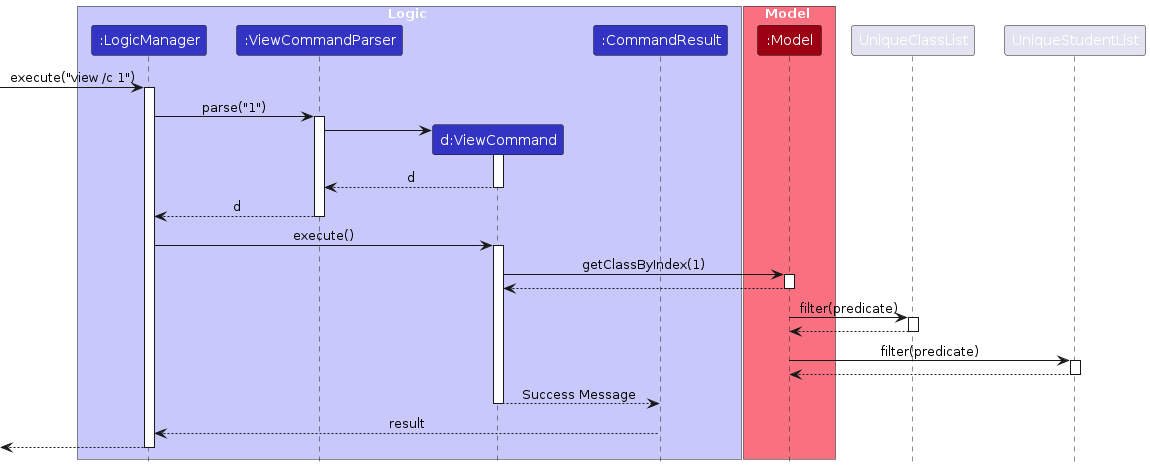
The following activity diagram summarises what happens when a user executes the View Command:
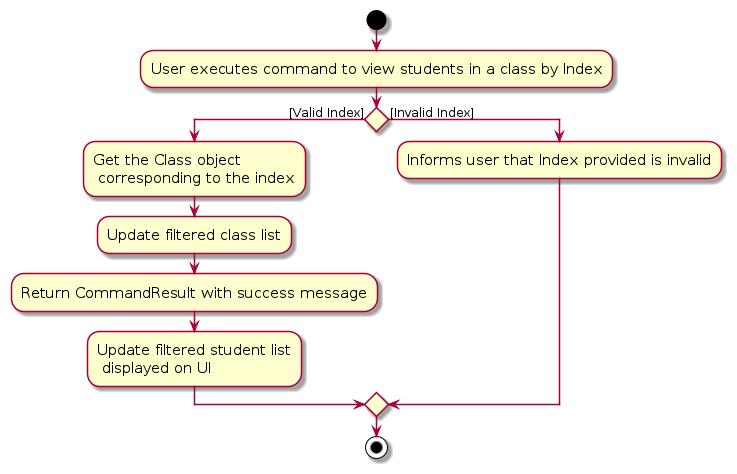
Add a class feature
Implementation
Given below is an example usage scenario and how the add class mechanism behaves at each step:
Step 1. The user launches the application.
Step 2. The user executes add /c cs2103t command to add a new class with the class name "CS2103T". The add /c command calls Parser#AddClassCommandParser to retrieve the provided class name argument.
Step 3. A new Class is created with the specified class name, an empty student list, an empty class note, and empty class schedule.
Step 4. The created Class is added to UniqueClassList if it does not exist in UniqueClassList. Then the Storage is updated to save the current state of EduTrack.
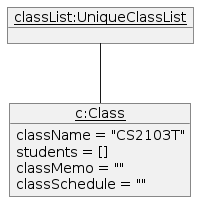
Step 5. The application prints the successful message to the user. UI automatically updates the current state of the shown class list.
Note:
- The received class name will be converted to uppercase using the
toUpperCase()method. - If the command fails its execution, the class list remains unchanged and an error message will be printed to notify the user.
The following sequence diagram shows how the add class operation works:
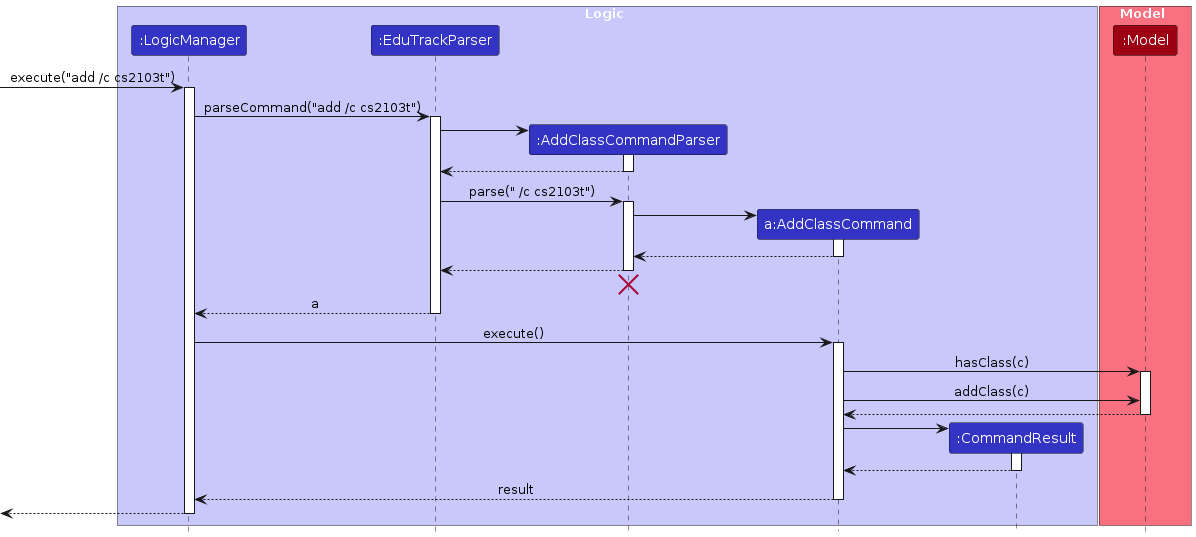
LogicManager#execute()is called.EduTrackParse#parseCommand()is called.AddClassCommandParser#parse()is called, and a newClass cis created. ReturnsAddClassCommand addClassCommand.addClassCommandcallsModel#hasClass(c). If the class does not exist, it callsModel#addClass(c).addClassCommandreturnsCommandResulttoLogicManager.
The following activity diagram summarizes what happens when a new Class is added:
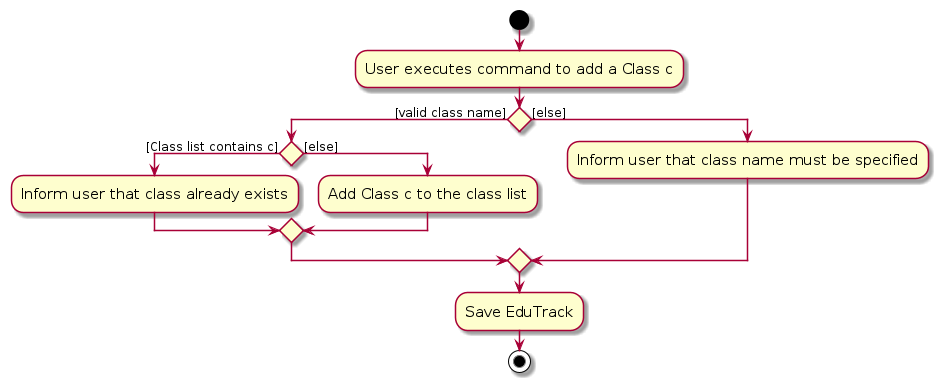
Design Consideration
Aspect: The number of parameters required
Alternative 1 (current choice): Creates a new class with only class name.
- Pros: Easy to implement.
- Cons: Needs to use another command to update class note and class schedule.
Alternative 2: Creates a new class with class name, class note and class schedule.
- Pros: All information are specified by the time the class is created.
- Cons: Requires the user to provide additional details like class notes or class schedule
Documentation, logging, testing, configuration, dev-ops
Appendix: Requirements
Product scope
Target user profile:
School of Computing (SoC) tutor who:
- needs to manage classes with a significant number of students
- needs to do tasks like taking attendance, and keeping track of class participation
- prefers desktop apps over other types
- can type fast
- prefers typing to mouse interactions
- is reasonably comfortable using CLI apps
Value proposition: Each tutor has multiple groups of students and each group can be large, and keeping track of students and records would become a hassle. Our product provides a centralized system that would help to organize all student records for easy and quick access.
User stories
Priorities: High (must have) - * * *, Medium (nice to have) - * *, Low (unlikely to have) - *
| Priority | As a … | I want to … | So that I can… |
|---|---|---|---|
* * * | TA | add a class | - |
* * * | TA | remove a class | - |
* * * | TA | view a class | view all students of a specific class |
* * * | TA | add a student | - |
* * * | TA | remove a student | - |
* * * | TA | save the data automatically | ensure that my data is not lost when I forget to save |
* * | TA | update a class | keep the class information up to date |
* * | TA | update a student | keep the student record up to date |
* * | TA | take attendance in a lesson | spend more time teaching |
* * | TA | monitor a lesson of a class | keep track of administrative information for each lesson |
* * | TA | find a specific student by using a filter | quickly update their record such as attendance when they are late |
* * | new user | see the app populated with sample data | easily see what the app looks like when it is in use |
Use cases
(For all use cases below, the System is EduTrack and the Actor is the user, unless specified otherwise)
Use case: See the app populated with sample data
MSS
User launches the app for the first time.
EduTrack populates the app with sample data.
Use case ends.
Use case: View all the information about a class
MSS
- User chooses a class out of all the classes they are teaching.
- User requests to view all the information about that class.
- EduTrack displays all the information about that class. (e.g. name, students, attendance, notes, etc)
Use case: Add a class
MSS
- User requests to add a class and specifies the class name.
- EduTrack adds the class to the list of classes.
- EduTrack shows the updated list of classes.
Extensions
1a. Class name is not specified.
1a1. EduTrack informs user that class name is empty.
Use case ends.
1b. Class name already exists.
1b1. EduTrack informs user that class already exists.
Use case ends.
Use case: Remove a class
MSS
User requests to view the list of classes.
EduTrack shows a list of classes.
User requests to delete a specific class in the list.
EduTrack deletes the class.
EduTrack informs the user that the class is successfully deleted.
Use case ends.
Extensions
3a. The given class index is invalid.
3a1. EduTrack informs the user the index provided is invalid.
Use case ends.
3b. No class index specified.
3b1. EduTrack informs the user the index provided is invalid.
Use case ends.
4a. EduTrack detects that the class does not exist.
4a1. EduTrack informs user that the class does not exist.
4a2. EduTrack terminates the request.
Use case ends.
Use case: Edit a class
MSS
- User requests to view the list of classes.
- EduTrack shows a list of classes.
- User requests to update either the class name, memo or schedule of a particular class.
- EduTrack overwrites the updated attribute of that particular class.
- EduTrack informs user of the new class details.
Extensions
2a. The list is empty.
Use case ends
3a. The provided class index is invalid.
3a1. EduTrack informs the user that class index is invalid.
Use case ends.
3b. User requests to edit class name but class name is not specified.
3b1. EduTrack informs the user to specify the class name.
Use case ends.
3c. The provided class name already exists in the class list.
3c1. EduTrack informs the user that class name already exists.
Use case ends.
Use case: Mark a student present for a lesson
MSS
User requests to view the students in a particular class.
EduTrack shows a list of students.
User requests to mark a student present.
EduTrack marks the student present, updates the student's lessons attended counter and current attendance.
EduTrack informs the user the student was successfully marked present.
Use case ends.
Extensions
2a. The list is empty.
Use case ends.
3a. The given student index is invalid.
3a1. EduTrack informs the user that the student index is invalid.
Use case ends.
3b. The given student index is empty.
3b1. EduTrack informs the user taht the student index is invalid.
Use case ends.
3c. The given class name is invalid.
3c1. EduTrack informs the user that the class does not exist.
Use case ends.
3d. No class name specified.
3d1. EduTrack informs the user that the class name is not specified.
Use case ends.
4a. The student to be marked present has already been marked as present.
4a1. EduTrack shows an error message to inform the user the student has already been marked present.
Use case ends.
Use case: Mark all students present in a class
MSS
User requests to view the students in a particular class.
EduTrack shows a list of students.
User requests to mark a student present.
EduTrack marks the student present, updates the student's lessons attended counter and current attendance.
EduTrack informs the user the student was successfully marked present.
Use case ends.
Extensions
2a. The list is empty.
Use case ends.
3a. The given class index is invalid.
3a1. EduTrack informs the user that the class index provided is invalid.
Use case ends.
3b. The given class index is empty.
3b1. EduTrack informs the user that the command format is wrong.
Use case ends.
Use case: Start a lesson
MSS
User requests to view the list of classes.
EduTrack shows a list of classes.
User chooses to start a lesson for one of the classes.
EduTrack starts a lesson for the chosen class.
Use case ends.
Extensions
1a. EduTrack shows an empty list.
Use case ends.
3a. EduTrack detects that the class name is not specified.
3a1. EduTrack informs user that the class name is not specified.
3a2. EduTrack terminates the request.
Use case ends.
3b. EduTrack detects that the class name is invalid.
3b1. EduTrack informs user that the class name is invalid.
3b2. EduTrack terminates the request.
Use case ends.
Use case: Add a student
MSS
- User requests to add a new student to an existing class.
- EduTrack adds the student into the specified class.
Extensions
1a. Not all required parameters are present.
1a1. EduTrack shows an error message.
Use case ends.
1b. Student already exists.
1b1. EduTrack informs user that the student already exists.
Use case ends.
1c. Class index is invalid.
1c1. EduTrack informs user that the class index is invalid.
Use case ends.
Use case: Remove a student
MSS
User chooses to remove a student from a class.
User requests to delete a specific student in a class.
EduTrack removes the student from that class.
Use case ends.
Extensions
2a. EduTrack detects that class name is not specified.
2a1. EduTrack informs user that class name is empty.
2a2. EduTrack terminates the request.
Use case ends.
2b. EduTrack detects that student index is not specified.
2b1. EduTrack informs user that student index is empty.
2b2. EduTrack terminates the request.
Use case ends.
2c. EduTrack detects that student index is not valid.
2c1. EduTrack inform user that student index is invalid.
2c2. EduTrack terminates the request.
Use case ends.
Use case: Edit a student
MSS
User requests to view the students from a particular class.
User requests to edit the details of a specific student in the list based on index.
EduTrack edits the records of the specified student from the specified class.
EduTrack updates and displays the student list of the class.
Use case ends.
Extensions
2a. Not all compulsory parameters are present.
2a1. EduTrack shows an error message.
Use case ends.
2b. Compulsory parameters are valid but none of the optional parameters are present.
2b1. EduTrack shows an error message.
Use case ends.
2c. Student index is invalid.
2c1. EduTrack informs user that the student index is invalid.
Use case ends.
2d. Class does not exist.
2d1. EduTrack informs user that class does not exist.
Use case ends.
2e. Another identical student is found.
2e1. EduTrack informs user the student already exists.
Use case ends.
Non-Functional Requirements
- Environment requirement:
- Should work on any mainstream OS as long as it has Java
11or above installed.
- Scalability:
- Should be able to hold up to 1000 persons without a noticeable sluggishness in performance for typical usage.
- Usability:
- A user with above average typing speed for regular English text (i.e. not code, not system admin commands) should be able to accomplish most of the tasks faster using commands than using the mouse.
- The user interface should be intuitive and user-friendly to minimize the learning curve for TAs.
- Performance
- The system should respond to user requests within a reasonable time frame (i.e. under 2 seconds).
Glossary
- Mainstream OS: Windows, Linux, Unix, macOS
- Database: A storage for all data to be stored in.
Appendix: Instructions for manual testing
Given below are instructions to test the app manually.
Note: These instructions only provide a starting point for testers to work on; testers are expected to do more exploratory testing.
Launch and shutdown
Initial launch
Download the jar file and copy it into an empty folder.
Double-click the jar file.
Expected: Shows the GUI with a set of sample contacts. The window size may not be optimum.
Saving window preferences
Resize the window to an optimum size. Move the window to a different location. Close the window.
Re-launch the app by double-clicking the jar file.
Expected: The most recent window size and location is retained.
List all classes
List all the classes that have been added into EduTrack.
Test case:
list
Expected: All the classes that have been added into EduTrack are shown. If the user is previously viewing a class, switches from class' student list to class list display.Test case:
list 1
Expected: Similar to the previous. Additional characters (except prefixes) after a whitespace are ignored.
Adding a class
Adding a class to EduTrack.
Test case:
add /c CS2103T
Expected: New class is added.Test case:
add /c cs2101
Expected: New class is added.Test case:
add /c cs2101
Expected: No class is added. Error details are shown.
Note: This has to be performed after test case 2.
Removing a class
Removes a class from EduTrack.
Prerequisites: List all classes using the
listcommand. Multiple classes in the list.Test case:
remove /c 1
Expected: The first class is removed from the list. Class name is shown in the response message.Test case:
remove /c 0
Expected: No classes are deleted. Error details are shown.
Viewing a class
Views the detailed information of a class.
Prerequisites: List all classes using the
listcommand. Multiple classes in the list.Test case:
view /c 1
Expected: Displays the student list of the first class as well as the class details in the Class information box.Test case:
view /c he
Expected: No change in display. Error details are shown.
Editing a class
Edits the details of a class in EduTrack.
Prerequisites: List all classes using the
listcommand. There is a class calledT1at index 1.Test case:
edit /c 1 /n T0
Expected: Name of the class is replaced withT0. Displays only the edited class and the edited details.
Starting a lesson
Starts the lesson of a class.
Prerequisites: List all classes using the
listcommand. The first class calledCS2103Thave multiple students.Test case:
startlesson /c CS2103T
Expected: Starts a new lesson for the classCS2103T. Displays the student list of the class and class information. All students' total attendance increases by 1 and are now all absent (ie. thePresentcolumn is allN).Some invalid test cases to try (Error details shown):
- Missing
/cprefix:startlesson - Missing class name:
startlesson /c - Non-existent class:
startlesson /c NOTACLASS
- Missing
Setting the number of lessons of a class
Sets the total number of a class.
Prerequisites: List all classes using the
listcommand. The first class calledCS2103Thas multiple students. The current total lessons of the class is5.Test case:
setlesson /c CS2103T /l 10
Expected: Sets the total lesson to 10 for the classCS2103T. Displays the student list and class details of classCS2103Tand the overall attendance will be out of10.Test case:
setlesson /c CS2103T /l 0
Expected: Sets the total lesson to 0 for the classCS2103T. Displays the student list and class details of classCS2103Tand the overall attendance will be out of0.
Note: This command is meant for users to edit the total lessons if they have incorrectlystartlesson. Thus, no checks are done to ensure/lis valid. Do not be alarmed by invalid attendance records if the command is used incorrectly.
Adding a student
Adds a student to a class.
Prerequisite: List all classes using the
listcommand. There is a class calledT1at index 1 with no students.Test case:
add /s John /c 1
Expected: A new student calledJohnis added to the first class (ie.T1). Displays the student list and class information of the class the student is added into (ie.T1).Some invalid test cases to try (Error details shown):
- Missing student name:
add /s /c 1 - Class index missing, or it is lesser or equal to 0:
add /s John /c,add /s John /c -1 - Class index larger than the number of classes:
add /s John /c 100 - Invalid student name used:
add /s R@chel /c 1
- Missing student name:
Removing a student
Removes a student from a class.
Prerequisite: View the first class called
CS2103Twith multiple students using theview /ccommand. Multiple students in the student list.Test case:
remove /s 2 /c CS2103T
Expected: The second student is removed from the classCS2103T. Displays student list of the class the student is removed from.Some invalid test cases to try (Error details shown):
- Invalid student index:
remove /s 100 /c CS2103T
- Invalid student index:
Editing a student
Edits a student record.
Prerequisite: View the first class called
CS2103Twith multiple students using theview /ccommand. There is a student namedBobin index 1 of the student list.Test case:
edit /s 1 /c CS2103T /n John /id A0000000U /m Quiet
Expected: Student's name is replaced withJohn, id is replaced withA0000000U, memo is replaced withQuiet. Details of the edited student is shown.Test case:
edit /s 1 /c CS2103T /p Answered some questions.
Expected: Ui's class participation column is updated toAnswered some questions.Details of edited student is shown.Some invalid test cases to try (Error details shown):
- No optional fields:
edit /s 1 /c CS2103T - Student index larger than the number of students in the class:
edit /s 100 /c CS2103T /m Bob
- No optional fields:
Marking a student present
Marks a student present for the current class.
Prerequisites: View the first class called
CS2103Twith multiple students using theview /ccommand. There is a student at index 2 who has not been marked present after a lesson have been started.Test case:
mark /s 2 /c CS2103T
Expected: Marks student at index 2 present. Display underPresentchanges fromNtoYand overall attendance increase by 1.Some invalid test cases to try (Error details shown):
- Student index = 0:
mark /s 0 /c CS2103T - Student index larger than student list:
mark /s 100 /c CS2103T - Class name that does not exist:
mark /s 2 /c NOTACLASS - Marking a student present again:
mark /s 2 /c CS2103T
- Student index = 0:
Marking a student absent
Marks a student present for the current class.
Prerequisites: View the first class called
CS2103Twith multiple students using theview /ccommand. There is a student at index 2 who has been marked present after a lesson have been started.Test case:
unmark /s 2 /c CS2103T
Expected: Marks student at index 2 absent. Display underPresentchanges fromYtoNand overall attendance decrease by 1.Some invalid test cases to try (Error details shown):
- Student index = 0:
unmark /s 0 /c CS2103T - Student index larger than student list:
unmark /s 100 /c CS2103T - Class name that does not exist:
unmark /s 2 /c NOTACLASS - Marking a student absent again:
unmark /s 2 /c CS2103T
- Student index = 0:
Marking all students in a class present
Marks all students present for the current class.
Prerequisites: List all classes using the
listcommand. The first class has multiple students.Test case:
markall /c 1
Expected: Marks all the students in the first class of EduTrack present where display underPresentchanges toY. Displays the student list of the class that is marked present.Some invalid test cases to try (Error details shown):
- Missing
/cprefix:markall 1 - Missing class index:
markall /c - Class index larger than class list:
markall /c 100
- Missing
Marking all students in a class absent
Marks all students absent for the current class.
Prerequisites: List all classes using the
listcommand. The first class has multiple students.Test case:
unmarkall /c 1
Expected: Marks all the students in the first class of EduTrack absent where display underPresentchanges toN. Displays the student list of the class that is marked absent.Some invalid test cases to try (Error details shown):
- Missing
/cprefix:unmarkall 1 - Missing class index:
unmarkall /c - Class index larger than class list:
unmarkall /c 100
- Missing
Help
Shows the help window that contains a link to the User Guide.
Note: If you minimize the window, using the help command will not do anything. Do look for the minimized window in the taskbar of your computer!
Test case:
help
Expected: Shows the help window successfully.Test case:
help 1
Expected: Shows the help window successfully. Additional characters (except prefixes) after a whitespace are ignored.
Clear
Clears all stored data in EduTrack.
Prerequisites: EduTrack is populated with data (classes, students, both, or none).
Test case:
clear
Expected: Clears all stored data in EduTrack. Clear will be successful even if EduTrack has no data.Test case:
clear 1
Expected: Clears all stored data in EduTrack. Additional characters (except prefixes) after a whitespace are ignored.
Saving data
Dealing with missing/corrupted data files
Make sure that there is a
./data/edutrack.jsonfile.
If not, open the application (the jar file), make some changes (e.g.add /c T1) and close the app (by typing in theexitcommand or clicking on the close button).Open
./data/edutrack.jsonin a text editor or an integrated development environment (IDE).Remove the starting
{character of the JSON file and save the file.Launch the app by running
java -jar edutrack.jarin the console or double-click the application.
Expected: The GUI should pop up with no entries. The console should give warnings about incorrect data format (due to the removal of the{character at the start of theedutrack.jsonfile). Now, you can start over and add whatever entries you want.
Note: If you want to start with populated data, delete the entireedutrack.jsonfile and launch the application.
Appendix: Planned Enhancements
- Enhancement to validation of identical students
As of now, to validate that 2 students are identical, the methodisSameStudentchecks if allStudent's fields: name, id, total attendance, current attendance, memo, and class participation are equal.
Thus, this allows the user to create (through adding or editing) 2 students that have 1 differing field apart from the name and id field. For example, there can be twoStudentwith name Bob, id A0123456Z but one with a memo of "Actively asks questions during class" and another with an empty memo. This can be confusing for the user if done unintentionally as the GUI would show 2 students that seem to represent the same student.
Enhancement to be made: The methodisSameStudentwill be adjusted so that 2 students are identical if and only if both their name and id are the same. This will ensure every student is unique (based on name and id) in EduTrack (i.e. even between different classes).